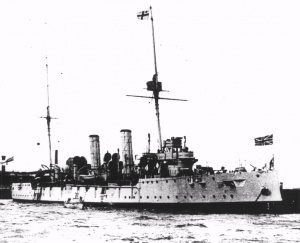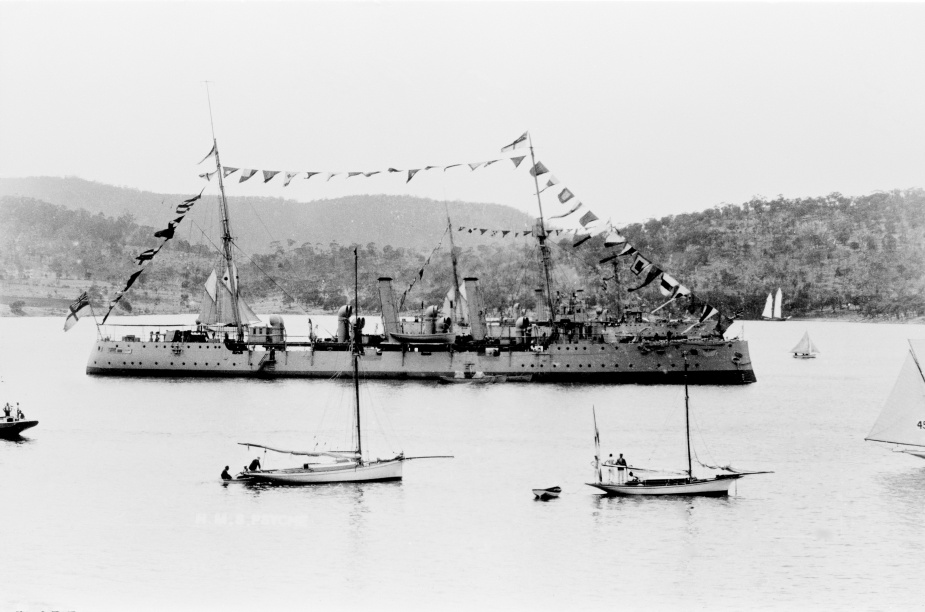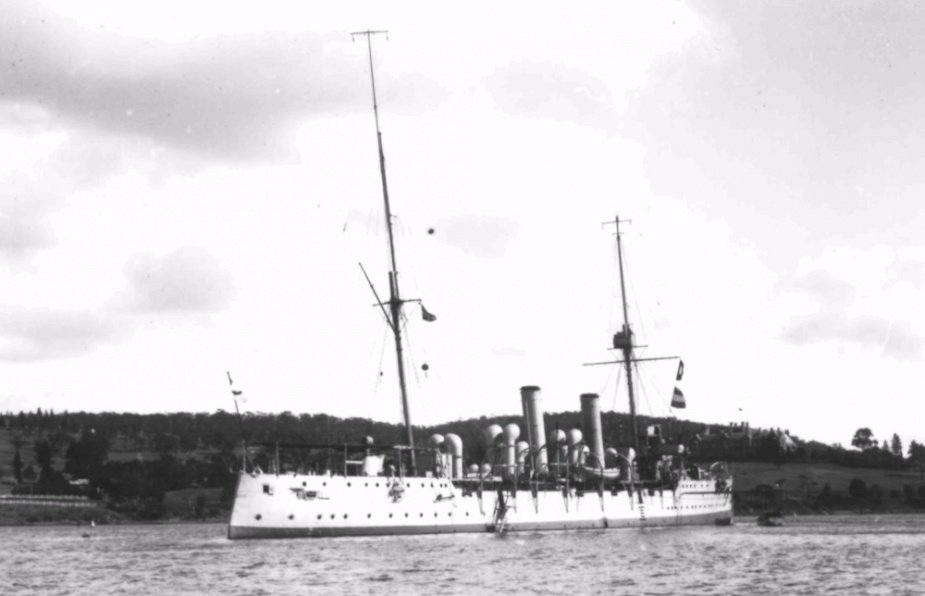HMS Psyche, a Pelorus third class protected cruiser named after the Greek mythological depiction of the soul, was laid down for the Royal Navy (RN) at the Devonport Dockyards on 15 November 1897. It commissioned in the RN on 2 May 1899. It served its first deployment in North American waters before departing for the Australia Station in September 1903 under the command of Commander R Cunningham-Foot, RN. It served on the Australia Station from December 1903 spending time in both the Pacific and Indian Oceans, and was one of just 3 RN cruisers still serving on the Station when the Australian Fleet Unit arrived in Sydney on 4 October 1913. It departed Australia shortly afterwards and was serving in New Zealand waters at the outbreak of the First World War on 4 August 1914.
The early months of the war were busy for Psyche as the cruiser was involved in the capture of the German Protectorate of Samoa as well as other German assets in the Pacific. It also formed part of the escort force for troop convoys bound for the Middle East from New Zealand. It decommissioned on 22 January 1915 and was laid up in Sydney.
On 13 May 1915, the Prime Minister’s Department requested that the Admiralty loan Psyche to the Royal Australian Navy (RAN) as a training vessel. The Admiralty responded positively on 1 June and exactly a month later, on 1 July, HMAS Psyche commissioned into the RAN under the command of Commander (later Rear Admiral) Henry Feakes, RAN.
Before Psyche could be commissioned, however, the Admiralty enquired with the Naval Board as to whether the cruiser might take a more active role in the war in Asia. Although the Middle and Far East were remote from the European theatres of war, Germany had been actively fomenting sedition in India and Burma as early as 1911, controlled primarily through the German embassy in Washington, even planning to smuggle arms and propaganda in support of a general uprising.
While the Allies were aware that such activity was taking place, they remained unaware of its specifics. Psyche and HMAS Fantome (Lieutenant Commander Lewis Jones, RN), at that time an unarmed surveying ship, were hastily prepared to form part of a patrol in the Bay of Bengal. Both ships were necessarily crewed by sailors still under training, augmented by experienced petty officers. Following a brief but intense work-up, Psyche departed Sydney on 16 August for Asian waters where it remained for the next 2 years.
War preparations were made en route and training for sailors under instruction continued throughout the voyage. The trainees and their instructors were only relieved from night war Stations once gunnery exercises had reached a degree of efficiency satisfactory to Commander Feakes.
Psyche arrived at Singapore on 4 September and departed 2 days later for Yangon with orders to organise a patrol scheme for the Burmese coast. Upon his arrival at Yangon on 10 September, Feakes found 3 vessels of the British India Steam Navigation Company’s fleet had already been taken up and were fitting out for patrol duties, each commanded by an officer of the Royal Indian Marine. He established a coastal patrol the very next day with a military detachment aboard each vessel.
Following a brief visit to Mandalay, where Commander Feakes discussed his patrol scheme with the General Officer Commanding, Yangon (Major-General Sir Herbert Raitt KCIE CB), Psyche returned to Yangon and set about correcting various engine room defects. Upon HMS Diana’s arrival on 20 September, Captain George Hutton, RN, assumed command of the Burma Coast Patrol and appointed Feakes as Senior Naval Officer, Burma, with the 3 armed patrol vessels and 10 coastal patrol launches under his command. Psyche proceeded to sea for its first patrol and inspection on 22 September.
Patrol and inspection duties remained the norm for Psyche for the remainder of the year. Patrols were typically of 10 to 12 days duration, at the conclusion of which the ship would return to Yangon for 2 to 4 days for coal. Training classes, drills, evolutions and gunnery exercises continued during the patrols, and variations in the weather, ranging from extreme heat in the north to heavy storms in the south, made conditions very difficult for the crew. A general malaise affected the ship during this period. From 14 October to 2 November, 12 crew members were admitted to hospital for various ailments while a further 14 were sick on board.
Following a brief voyage to the Andaman Islands to relieve Fantome in January 1916, Psyche returned to Yangon on 17 January 1916 where orders were received to demobilise the Burma Coast Patrol, which was completed a week later. By this time it had become apparent that any German plots in India and Burma had collapsed and that the centres of intrigue had shifted to the neutral territories of the Malay Peninsula. Psyche proceeded to Penang, where it arrived on 28 January, to await further orders. The following day 8 sailors and an engineer midshipman were discharged to the sloop HMAS Una for passage back to Australia having been found unfit for service in the tropics.
Psyche departed Penang at the end of the month for Port Blair where it was placed at short notice for service in the area as well as conducting periodical patrols off the east and west coasts of Sumatra.
On 12 February, while visiting Port Swettenham (Kelang), tensions aboard ship finally came to a head and 7 stokers refused duty, an action that eventually led to their respective court martials. There were a number of issues that led to this incident: Psyche was an old ship with little to alleviate the difficult conditions experienced in the tropics; the long and monotonous hours spent on patrol; an intensive training program; the malaise which affected the crew almost from commissioning; but the one thing which eventually brought these tensions to the surface was food.
Complaints about the food on board were common virtually from the time Psyche left Australian waters. Tinned fish, green or rotten meat and rotten eggs were all too common in Psyche’s mess with one stoker testifying that the food he himself obtained while in port was of a better quality than that served up by the mess.
At 10pm on 12 February, Stoker Albert Hummerston refused duty in protest at the standard of food on board and was consequently placed under sentry’s charge. Over the course of the evening 6 more stokers refused duty in support of their shipmate and all were consequently placed under sentry’s charge. All 7 were found guilty of wilful disobedience of a lawful command at their respective courts-martial and received sentences ranging from 12 to 24 months imprisonment as well as dismissal from the RAN. With the stokehold operating with a reduced complement, 15 stokers were taken on in Singapore for temporary employment until a draft of 10 RAN stokers joined the ship on 25 April.
Psyche returned to patrol duties in the Gulf of Siam on 7 March before returning to Singapore on 17 March. It departed Singapore once again 2 weeks later acting as escort for a convoy of Russian military transports headed for Europe. Relieved by HMS Venus on 4 April, Psyche returned to Port Blair for patrol duties in the Bay of Bengal. While at Port Blair, the opportunity was taken to land one watch every day, weather permitting, for rifle drills or a route march, and sea bathing. It was the monsoon season, however, and strong winds and heavy rain were common.
Psyche continued on patrol duties until 2 July when it arrived at Hong Kong for its annual inspection and refit. During this period, 6 officers and more than 70 sailors were landed to the naval hospital at Hong Kong for treatment of various ailments including Dengue Fever and other similar conditions. Combined with some 40 more sailors and an officer sick on board, around half of Psyche’s complement were incapacitated due to illness. The situation prompted the ship’s surgeon, Clifford Henry, to report that the crew was in urgent need of a spell in a cold climate.
Meanwhile on 6 July, Lieutenant Herbert Teale, RN, commissioned HMS Moorhen for local river service, crewed by 36 sailors from Psyche with Surgeon Henry acting as the ship’s medical officer. Moorhen decommissioned on 23 July and the crew rejoined Psyche, which recommenced patrol duties off the south coast of China, based at Hong Kong, on 14 August. These operations, once again, proved to be long and arduous, though Commander Feakes was pleased to report a general improvement in the overall health of the ship’s company, possibly due to the cooler conditions off the Chinese coast.
Operations in Chinese waters continued until 14 October 1916 when the ship was ordered to Singapore. Patrols in the Bay of Bengal and off the coast of Sumatra recommenced on 20 October, beginning with a patrol and flag-showing cruise taking in Penang, Port Blair, Yangon, Kolkata, Chennai and Colombo. These operations continued until late March 1917 when Psyche was detached for escort duties for military transports between Burma and India, which continued through April and May, before returning to patrol duties in June.
On 16 July 1917, Psyche returned to Singapore where it remained, apart from a brief cruise acting as escort for the merchant vessel Tantalus, awaiting the arrival of its relief, the cruiser HMS Suffolk. Suffolk arrived on 11 August and Psyche departed Singapore on 31 August for Sydney via Dili, Thursday Island, Townsville and Brisbane. It arrived in Sydney, in dire need of a refit, on 28 September and decommissioned on 16 October.
Psyche’s service in Asia had come to an end more than 2 years after it had departed Sydney, and the ship had not fired a shot in anger. The crew, however, had performed an arduous task, preventative in nature and typical of naval patrol work. On the surface, the lack of enemy encounters may lead some to question the value of the work done by Psyche in Asia. Indeed, the crew themselves questioned its value and wondered what contribution had they made to the war effort. However, considering the evidence of German supported seditious activity which emerged after the war, that lack of enemy action is proof of the success of Allied operations in the area. The presence of Psyche and other Allied ships became well known in the Bay of Bengal and played a central role in preventing the very real possibility of a general uprising, which probably would have resulted in the redeployment of Allied forces away from the decisive struggle in Europe.
Psyche recommissioned again on 20 November 1917 under the command of Commander George Curtis, RAN, for patrol duties primarily off the Queensland coast, prompted by the actions of German raiders in and around Australian waters in 1917. After a brief and largely uneventful commission of just 5 months, Psyche decommissioned for the last time on 26 March 1918.
Psyche remained moored in Sydney Harbour and was eventually sold as a timber lighter on 21 July 1922. It later sank in Salamander Bay, Port Stephens.
Specifications
 |
| Class |
Pelorus Class |
|---|---|
| Type |
Light Cruiser (3rd Class Protected Cruiser) |
| Builder |
Devonport Naval Dockyard, England |
| Laid Down |
15 November 1897 |
| Launched |
19 July 1898 |
| Commissioned |
1 July 1915 |
| Decommissioned |
26 March 1918 |
| Dimensions & Displacement | |
| Displacement | 2200 tons |
| Length | 313 feet 9 inches |
| Beam | 36 feet 9 inches |
| Draught | 17 feet 6 inches |
| Performance | |
| Speed | 19.5 knots |
| Complement | |
| Crew | 224 |
| Propulsion | |
| Machinery | Inverted 3 cylinder triple expansion steam engines, 2 shafts |
| Horsepower | 7000 |
| Armament | |
| Guns |
|
| Torpedoes | 2 x 14-inch torpedo tubes |
| Awards | |
| Battle Honours | CHINA STATION 1915-1917 |

